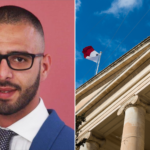
The University of Malta today welcomed over 3,573 new students, with 2,234 students looking to follow undergraduate courses, while 1,339 students will be reading for postgraduate degrees.
This is a special year for the University, as it is celebrating its 250th year
University of Malta Rector Alfred Vella opened his welcoming speech by mentioning the university’s establishment by Grand Master Pinto following a papal decree (Clement XIV) to permit the act, as was required in Roman Catholic Europe at the time in 1769.
Vella pointed out that UoM had found its place on the prestigious world university rankings administered by the Times Higher Education, with the university being ranked with the top 3% in terms of excellence of performance out of 28,000 other universities.
“Especially for you, undergrad freshers, the overwhelming interest should probably be that related to the ability of the University to provide you with a good teaching and learning experience, since your degree shall be assured if you’re properly looked after and supported in your learning by a high quality environment for the next three or four years.”
He then insisted that “a university without a significant research output is only so in name”, and that “to perform substantial and impactful research, the University needs to have enough money at its disposal”.
The rector reported that they had recently acquired EU funds “running into multimillion Euro to permit us to develop and expand our research infrastructure”, which would hopefully help in pushing the country higher on the Eurostat statistics which give Malta low points in Research and Development graphs.
“We will continue to ask for additional money from our State in order to be able to attract to our faculties more masters and especially full time doctoral and post-doctoral researchers without whom the work cannot happen in sufficiency.”
Moving into the digital realm, Vella touched on the Internet and Artificial intelligence, which he said would be “another driver with the power to enhance the creative instincts of learners and researchers with outcomes that are only just becoming apparent”.
He also touched on massive open online courses (MOOCs), which he insisted would have an “important and permanent role to play in university business” and that “UoM is already exploiting this resource” for the benefit of its students.
“Going forward, we shall continue to embrace the virtual digital reality because when professionally created and delivered, such content can enhance the quality of learning and teaching and of course the extent of its dissemination.”
The rector also celebrated the approval of the plans for the building of a Sports and Performance Centre, with the set target of delivering the facility to the students and staff within two or three years, coinciding with the completion of the project for student residences on campus.
“These are projects that, when completed, should represent a quantum leap in terms of quality of the University experience which we owe to our constituents.”
It wouldn’t be a formal speech at a university without a dash of gender politics, as the rector then turned his attention to the “national problem” of the “stark gender divide in political leadership”, whilst also speaking of the “dominance” of the female presence, where from the 3542 graduates of last year, 58% were female, and the fact that there are now 2,300 more female students.
In fact, he notes this is “despite the fact that University provides the workforce and society with a steady stream of highly educated women that outnumber similarly educated men”.
The different intersts and choices of the two genders, easily seen in the make up of various courses, explains this disparity, and also explains the rectors next assertion where he said that “a similar gender divide also exists at the University where although 34% of academic full time staff are female, only 17% of full professors are women”.
“We need to find sensible ways to promote better gender parity in our national institutions, including the University, because as in biological ecosystems, the more varied and richer the mix of species, the more stable the system.”
The rector also announced the production of the first Strategic Plan for 2020-2025 following a process of elaborate and wide consultation among staff and students of UM as well as stakeholders beyond the campus: a campaign that involved communication with 15000 persons and almost a year of work and effort.
“The Plan will keep us focused but of course it will not detract from our efforts to exploit any prospects that may present themselves as the story of L-Universita’ ta’ Malta continues to unfold in the coming years.”
“We’ve been here, through thick and thin, for 250 years: long may L-Universita’ endure and meanwhile remain true to its motto, that of “serving students, scholarship and society sustainably”.”
Facts and Figures
The University of Malta welcome over 3,573 new students on Monday, with 2,234 students looking to follow undergraduate courses, while 1,339 students will be reading for postgraduate degrees.
Another 914 new students will be joining Junior College, to bring the total number of new students to 1,770.
On the international side of things, a total of 950 international students representing 111 different countries will be pursuing studies at the University this year.
Overall, the total number of students at the University of Malta for the academic year 2019-2020 is 11,750, of which 4,739 are male and 7,011 are female – all of whom are to follow a total of 921 courses.
This academic year also marks the first year of the newly introduced Master of Science in Blockchain and Distributed Ledger Technologies postgraduate course which was started up in the hope that a substantial number of individuals would have graduated in time for the current government’s objective of making Malta the “Blockchain Island”.







